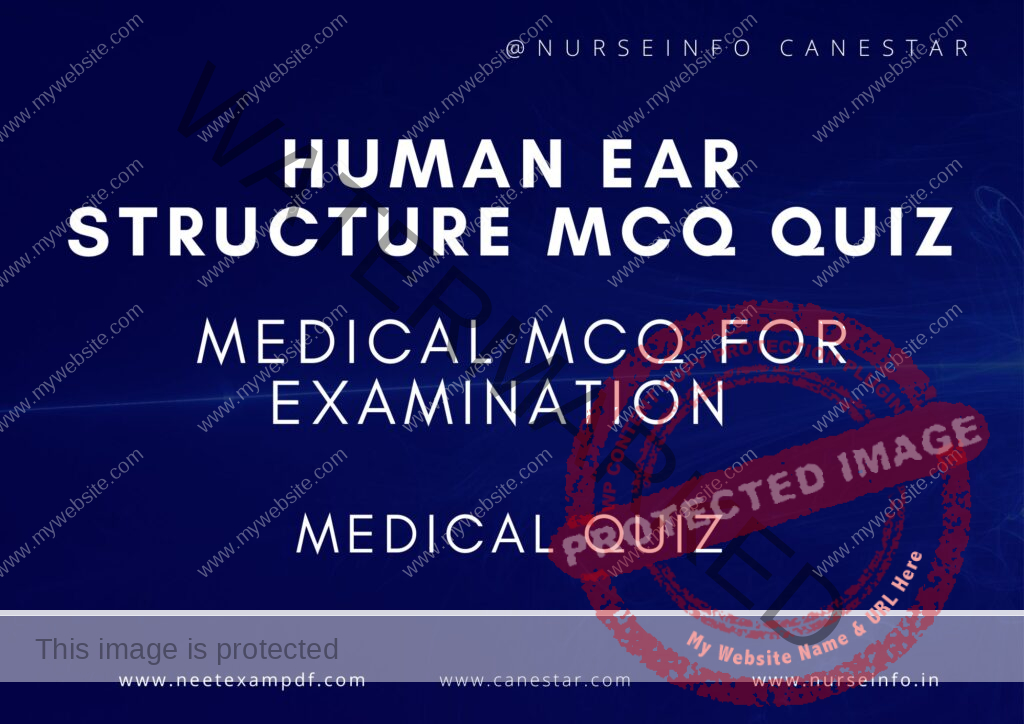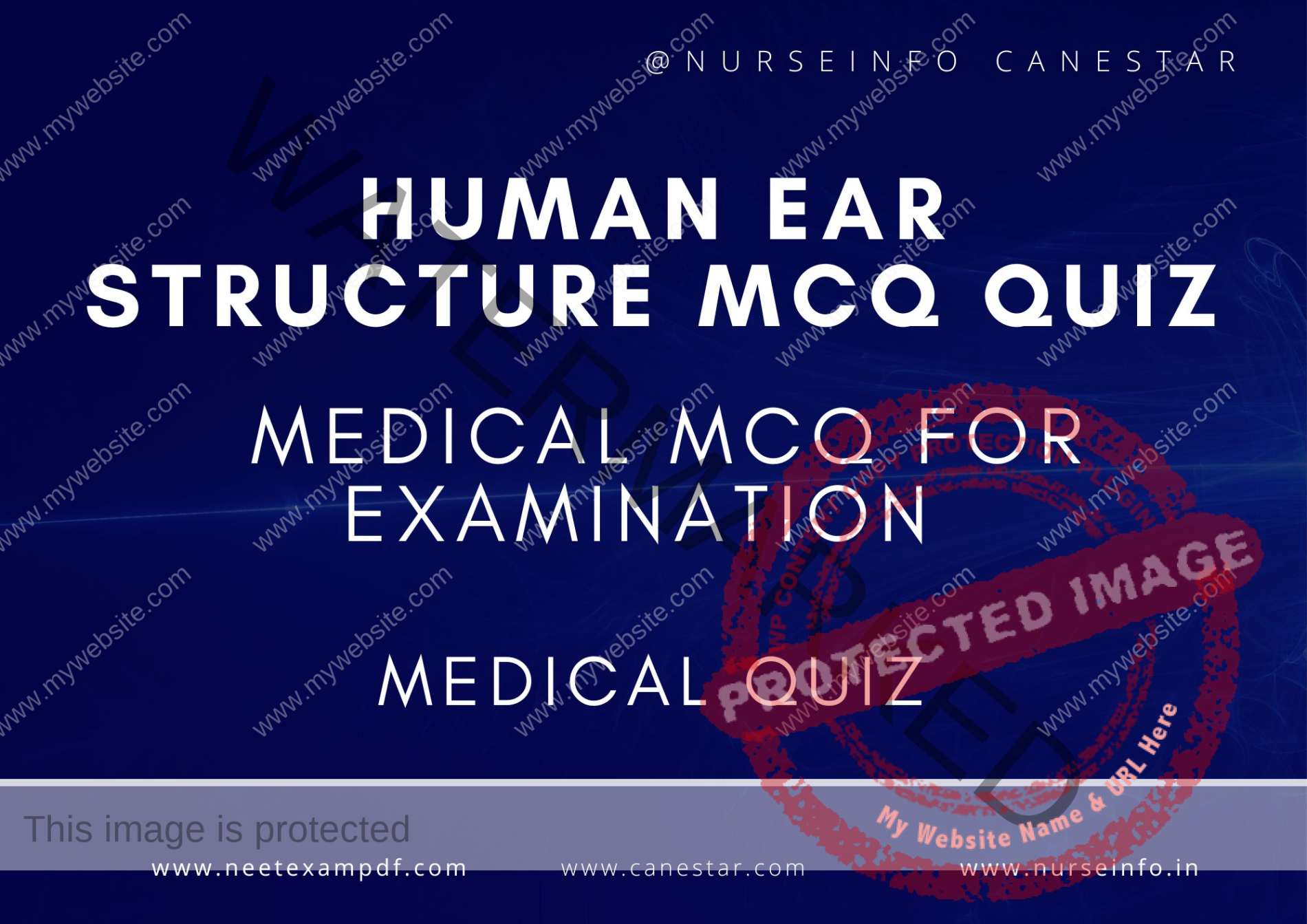MULTIPLE CHOICE QUESTIONS ON STRUCTURE OF HUMAN EAR QUIZ – MCQS WITH RATIONALE ANSWER – HUMAN EAR MCQ QUESTIONS
MCQ FOR HUMAN EAR STRUCTURE QUIZ
These mcqs are prepared exclusively for medical professionals for exam preparation. MCQ is helpful to remember the concept on human ear structure and function mcq quiz. This multiple choice questions are helpful for preparation for DHA, PROMETRIC, MOH, HAAD, NCLEX, Medical, NEET and Nursing EXAMINATION
HUMAN EAR MCQ QUIZ
Human Ear MCQs with Rationale Answer
Which part of the ear is responsible for transmitting sound waves to the ossicles?
a) Cochlea
b) Tympanic membrane
c) Eustachian tube
d) Semicircular canals
Answer: b) Tympanic membrane
Rationale: The tympanic membrane (eardrum) vibrates in response to sound waves and transmits these vibrations to the ossicles in the middle ear.
What is the main function of the Eustachian tube?
a) Amplify sound
b) Balance pressure between the middle ear and the atmosphere
c) Detect head position
d) Produce earwax
Answer: b) Balance pressure between the middle ear and the atmosphere
Rationale: The Eustachian tube helps equalize air pressure on both sides of the tympanic membrane, ensuring proper vibration and hearing.
Which structure in the inner ear is responsible for hearing?
a) Semicircular canals
b) Vestibule
c) Cochlea
d) Malleus
Answer: c) Cochlea
Rationale: The cochlea is a spiral-shaped organ in the inner ear that contains hair cells which convert sound vibrations into neural signals for hearing.
What is the role of the ossicles in the middle ear?
a) To produce earwax
b) To amplify and transmit sound from the tympanic membrane to the inner ear
c) To detect head movements
d) To equalize pressure in the middle ear
Answer: b) To amplify and transmit sound from the tympanic membrane to the inner ear
Rationale: The ossicles (malleus, incus, and stapes) amplify sound vibrations and transmit them to the oval window of the cochlea.
Which part of the ear is primarily involved in balance and spatial orientation?
a) Cochlea
b) Tympanic membrane
c) Semicircular canals
d) Eustachian tube
Answer: c) Semicircular canals
Rationale: The semicircular canals in the inner ear are filled with fluid and contain hair cells that detect rotational movements of the head, aiding in balance.
What is the function of earwax (cerumen)?
a) To amplify sound
b) To lubricate and protect the ear canal
c) To transmit vibrations to the ossicles
d) To detect changes in air pressure
Answer: b) To lubricate and protect the ear canal
Rationale: Earwax (cerumen) protects the ear canal by trapping dust and debris, and it also has antimicrobial properties.
Which nerve carries auditory information from the cochlea to the brain?
a) Facial nerve
b) Vagus nerve
c) Vestibulocochlear nerve
d) Trigeminal nerve
Answer: c) Vestibulocochlear nerve
Rationale: The vestibulocochlear nerve (cranial nerve VIII) transmits auditory information from the cochlea to the brain.
What is the role of the oval window in hearing?
a) To protect the middle ear from loud sounds
b) To equalize pressure in the ear
c) To transmit vibrations from the stapes to the cochlea
d) To produce earwax
Answer: c) To transmit vibrations from the stapes to the cochlea
Rationale: The oval window is a membrane-covered opening that receives vibrations from the stapes and transmits them into the fluid-filled cochlea.
Which part of the ear contains the organ of Corti?
a) Middle ear
b) Outer ear
c) Inner ear
d) Eustachian tube
Answer: c) Inner ear
Rationale: The organ of Corti, located in the cochlea of the inner ear, contains hair cells that convert sound vibrations into electrical signals.
What is tinnitus?
a) Inflammation of the ear canal
b) Ringing or buzzing noise in the ears
c) Loss of balance
d) Excessive earwax production
Answer: b) Ringing or buzzing noise in the ears
Rationale: Tinnitus is the perception of ringing, buzzing, or other noises in the ears that are not caused by an external sound.
Which condition is characterized by a buildup of fluid in the middle ear?
a) Otitis externa
b) Otitis media
c) Otosclerosis
d) Meniere’s disease
Answer: b) Otitis media
Rationale: Otitis media is an infection or inflammation of the middle ear that often involves a buildup of fluid behind the tympanic membrane.
What type of hearing loss is caused by damage to the inner ear or auditory nerve?
a) Conductive hearing loss
b) Sensorineural hearing loss
c) Mixed hearing loss
d) Functional hearing loss
Answer: b) Sensorineural hearing loss
Rationale: Sensorineural hearing loss is caused by damage to the inner ear (cochlea) or the auditory nerve, affecting the transmission of sound signals to the brain.
Which structure separates the outer ear from the middle ear?
a) Cochlea
b) Tympanic membrane
c) Eustachian tube
d) Semicircular canals
Answer: b) Tympanic membrane
Rationale: The tympanic membrane, or eardrum, separates the outer ear from the middle ear and vibrates in response to sound waves.
Which test is commonly used to evaluate hearing loss by comparing air conduction to bone conduction?
a) Rinne test
b) Weber test
c) Audiometry
d) Tympanometry
Answer: a) Rinne test
Rationale: The Rinne test compares air conduction and bone conduction of sound to help determine the type of hearing loss.
What is the most common cause of conductive hearing loss?
a) Earwax impaction
b) Noise exposure
c) Aging
d) Meniere’s disease
Answer: a) Earwax impaction
Rationale: Conductive hearing loss is often caused by obstructions such as earwax impaction, which blocks the transmission of sound to the inner ear.
Which structure in the ear is responsible for detecting linear acceleration and head position?
a) Cochlea
b) Tympanic membrane
c) Vestibule
d) Ossicles
Answer: c) Vestibule
Rationale: The vestibule contains the utricle and saccule, which detect linear acceleration and head position relative to gravity.
What is the primary function of the hair cells in the cochlea?
a) To produce earwax
b) To detect sound vibrations and convert them into electrical signals
c) To maintain balance
d) To amplify sound waves
Answer: b) To detect sound vibrations and convert them into electrical signals
Rationale: Hair cells in the cochlea are sensory receptors that detect sound vibrations and convert them into neural signals for hearing.
Which condition involves abnormal bone growth in the middle ear, leading to hearing loss?
a) Otosclerosis
b) Otitis externa
c) Tinnitus
d) Vertigo
Answer: a) Otosclerosis
Rationale: Otosclerosis is characterized by abnormal bone growth around the stapes bone in the middle ear, leading to conductive hearing loss.
Which of the following is a symptom of Meniere’s disease?
a) Earwax impaction
b) Persistent cough
c) Episodic vertigo
d) High fever
Answer: c) Episodic vertigo
Rationale: Meniere’s disease is a disorder of the inner ear that causes episodes of vertigo, tinnitus, and fluctuating hearing loss.
Which hearing test involves the use of an audiometer to measure hearing sensitivity?
a) Rinne test
b) Weber test
c) Audiometry
d) Tympanometry
Answer: c) Audiometry
Rationale: Audiometry is a hearing test that uses an audiometer to measure an individual’s hearing sensitivity across different frequencies.


